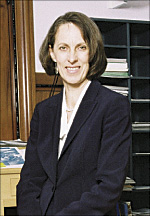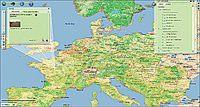ArcNews Online
Fall 2010
[an error occurred while processing this directive]European Union's Environmental Map Services Move to Cloud

Through EEA, the quality of bathing water can be assessed across Europe for quick understanding of information and trends in each country and across time.
The European Union's (EU) European Environment Agency (EEA) is working closely with Esri to improve the agency's cloud environment map services. EEA and Esri have signed a memorandum of understanding that allows EEA to expand deployment of ArcGIS 10 and better fulfill its project goals. European countries will be able to share environmental data more easily, and agencies, scientists, and policy makers will have quick access to data for viewing and analysis in GIS.
EEA helps EU and its member countries make informed decisions about improving the environment, integrating environmental consideration into economic policies, and moving toward sustainability. It also coordinates the European Environment Information and Observation Network (Eionet). Esri's complete integrated software system ArcGIS 10 plays a prominent role in helping EEA achieve its goal of delivering geographic visualization and analysis capabilities to environmental data consumers.
"We were very pleased to sign a new agreement with Esri for use of its ArcGIS 10 software," says EEA executive director Jacqueline McGlade. "This relationship will enable the 450 institutions participating in Eionet to access the software and will allow us to develop technologies, such as mobile GIS, within our community."
EEA collaborates with its member countries in the European Commission's Shared Environmental Information System (SEIS) initiative. The initiative aims to improve data availability and quality, streamline data handling, modernize reporting, and foster the development of information services and Web-based applications. Many countries have started to apply the principles of SEIS, which are based on distributed information management. Several European initiatives are providing the building blocks for SEIS, including
- Infrastructure for Spatial Information in Europe (INSPIRE)—A European Union directive to create a spatial data infrastructure that enables sharing geospatial data among European public-sector organizations and with the public
- Global Monitoring for Environment and Security (GMES)—A collaboration between the European Commission and the European Space Agency for the establishment of a European capacity for earth observation from space and in situ that supports sustainable development and global governance
- Water Information System for Europe (WISE)—EEA and European Commission's Internet tool that informs citizens about water quality and EU water policy
- Ozone Web—EEA portal for near real-time ozone information
- Eye on Earth—EEA's two-way communication platform, which brings together scientific information with feedback and observations of millions of ordinary people via social networking sites
- Biodiversity Information System for Europe (BISE)—A Web portal for data and information on biodiversity in the European Union

EEA executive director Jacqueline McGlade.
These services are transitioning to cloud computing, wherein technological capabilities are commonly maintained off premises and delivered on demand as services via the Internet. An advocate of cloud computing, McGlade notes, "Our community has a great appetite for all kinds of applications, and we can move these in and out of the cloud as needed. Every time we add a new service that has a transaction element, we see the access numbers go up and up. We have to accommodate the fact that the more information we put out there, the more people want to look at it. We anticipate that people want to do their own start-ups and their own applications out of the reference data that we are creating."
Cloud GIS offers data storage, end-user Web applications, and focused computing services. It costs less, is always available, has faster application delivery, is flexible, and has improved business continuity. Most importantly, it enables collaboration and community computing for easier and faster information sharing.
"Costs of this type of service are falling and tumbling," continues McGlade. "As far as cost, EEA is looking at a significant reduction of costs by moving to the cloud technology." Together with the development of Web mapping services offered by EEA, a much larger user community is served with high-quality, up-to-date environmental data.

EEA gives access to the CORINE land cover, a European land cover map produced by photointerpretation of Landsat ETM+ images as well as LUCAS (land use/cover area frame survey) to estimate areas that do not coincide with the administrative regions.
The memorandum of understanding supports the design and development of a means for sharing and accessing essential geographic environmental data provided by the agency's 32 member countries and 6 cooperating countries in approximately 450 organizations. During the next year, EEA and Esri will work together to develop
- Cloud architecture that serves EEA initiatives and European Union directives
- Data sharing that is in line with the principles of INSPIRE and SEIS
- Standardized templates and layer definitions that are based on the Esri Community Basemaps initiative
- A collaborative plan that supports the Eye on Earth initiative
"We want our users to be able to access multiple layers, do their own mashups, and create their own applications," explains McGlade. "GIS technology is moving rapidly ahead. In our latest discussions with Esri, we talked about crowdsourcing and mashing possibilities and getting data into the working environment so that people in the field can use GIS for analysis. Esri's providing the way to make this happen."
More Information
For more information, contact Guenther Pichler, Esri (e-mail: gpichler@esri.com).
See also "Migration to ArcGIS Server Improves EEA Map Services".
Related Podcast
The Cloud and GIS
Esri's IT strategist Victoria Kouyoumjian discusses the significance of cloud computing as a platform for developing and delivering GIS services. Listen to the podcast. [12:31 | 30 MB]